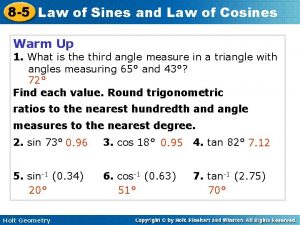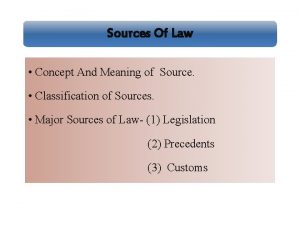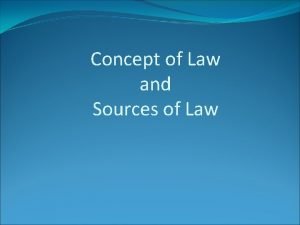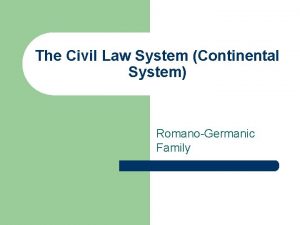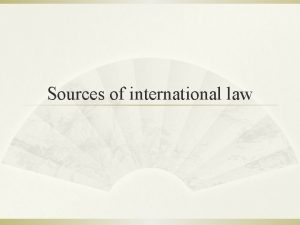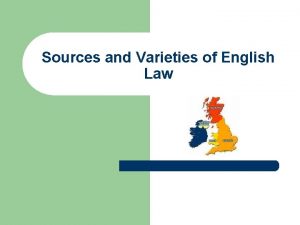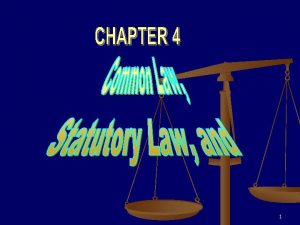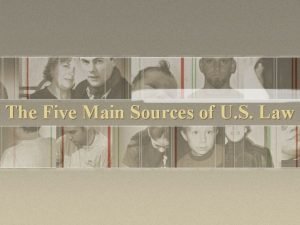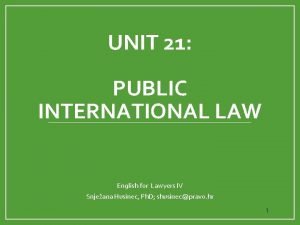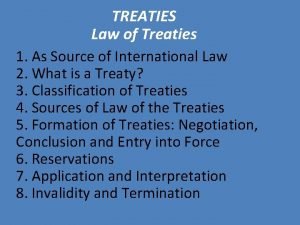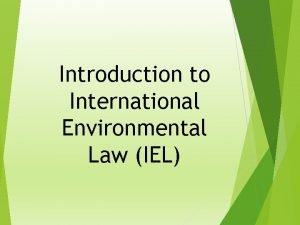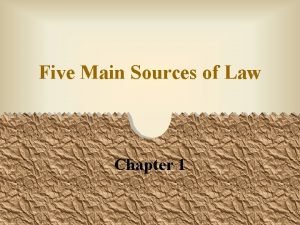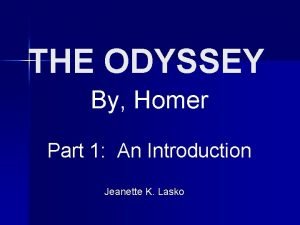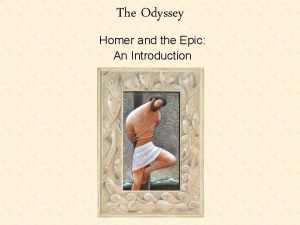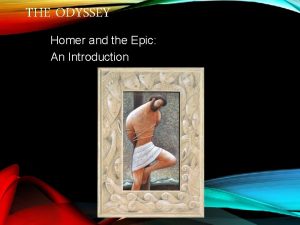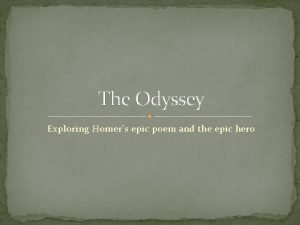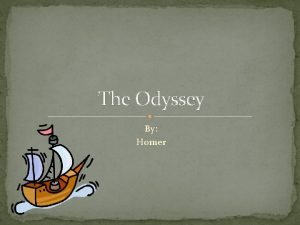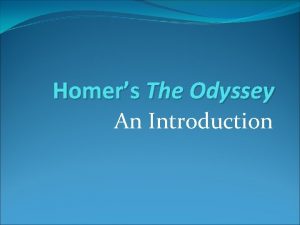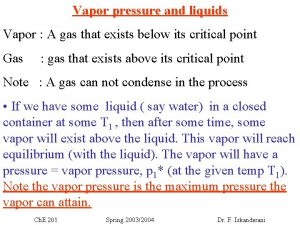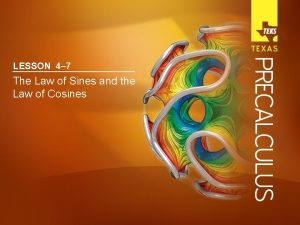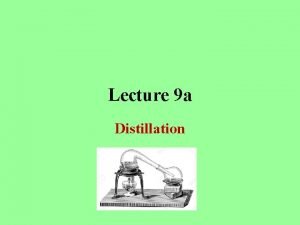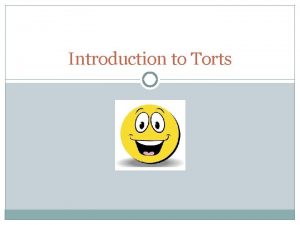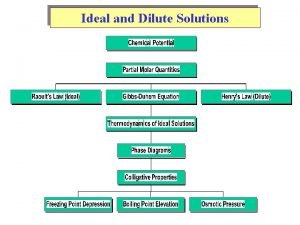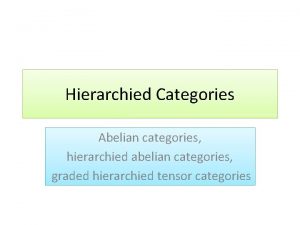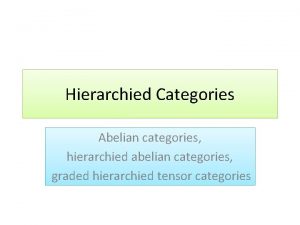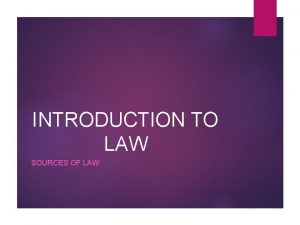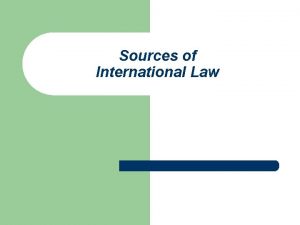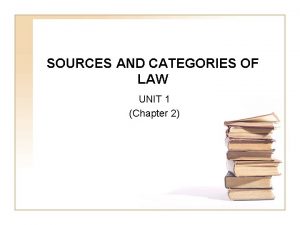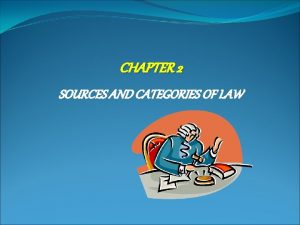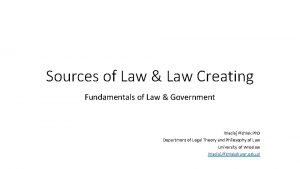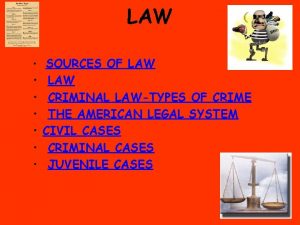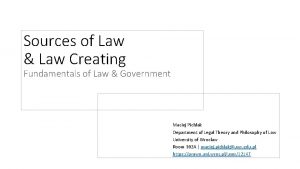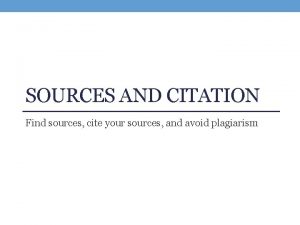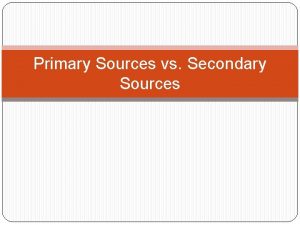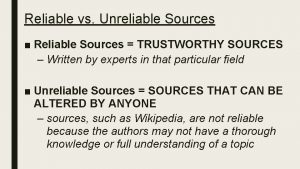Introduction to Law Part 1 Categories and Sources











































- Slides: 43

Introduction to Law – Part 1 (Categories and Sources of Law) 1

LEARNING OUTCOMES n n Module syllabus Course assessment Proposed exam format Introduction to law – Categories of law – Sources of law 2

Learning Strategies n Lecture n Cases and case briefs n Review papers n Project/presentation n Exams 3

Expectations n Participate! Law is sometimes difficult; it’s easier when you are involved! n Typed assignments, with name, student number and section. n Ask questions! 4

Course Assessment n Class participation n Mid-term exam n Coursework n Final exam 10% 20% 30% 40% 5

Course Work n Case briefs and presentations n Projects and presentations n Participation 6

Case Briefs Vauxhall Estates Ltd v. Liverpool Corporation (1932) n Example: n Diagramming the case 7

Case Brief – Vauxhall Estates Title: Vauxhall Estates v. Liverpool Corporation (1932) n Facts: In 1928, the UK Ministry of Health made a plan for street improvements. As part of the plan, the government required some landowners to sell their property to the government. The government would be required to pay the landowners for the property. n Issue: Whether the 1925 Act or the 1919 Act applies for the purposes of determining how much money sellers receive. n 8

Case Brief (Cont. ) Decision: The 1925 Act impliedly repeals the 1919 Act. n Reasoning: The 1919 Act is inconsistent with the later passed 1925 Act. n Analysis: This is an important case because it shows that laws more recently passed by Parliament may repeal earlier laws if they are inconsistent. That means that Parliament doesn’t have to expressly repeal a law in order for it to no longer be valid. n 9

Learning Objectives n What is law? n Categories of law n Sources of Law n Brief Comparison of England China 10

What is Law? n Law provides rules n It tells us what we can and cannot do n This is true in our personal lives (eg criminal law) n And in our business lives (eg contract law) n Therefore, it is important for a businessperson to know the rules which apply to them 11

What is Law? (cont. ) n However, law is more than just rules n Societies require order to allow people to live and deal with each other n Law is a means of creating and maintaining social order n It does this by helping to deal with arguments and conflicts 12

What is Law? (cont. ) n Different countries have different forms of law and social order n In this module, we shall be looking at some of the principles of English Law n However, many of these principles can be found in other legal systems – even if the details are different 13

Categories of Law is a very large field, and it is common to divide it into categories n common law and civil law n common law and statute law n private law and public law n civil law and criminal law 14

Common Law and Civil Law n. A legal system is the way the law is structured and operated in a country – England China have different legal systems n Common Law and Civil Law are terms used to describe legal systems 15

Common Law n Common Law is used to describe legal systems based on the English legal system n These are usually countries which were once part of the British Empire – eg: America, Australia, New Zealand 16

Civil Law n Civil Law is used to describe legal systems which are based on old Roman Law (from the Roman Empire in what is now Italy) n eg: France, Germany n China is usually classified as a civil law system, although it is not based on Roman Law 17

Common Law v. Civil Law Common Law n Case law and the courts are most important source of law Civil Law n Consists of a legal code of general principles which is the source of law 18

Common Law and Statute Law n Common Law is the law and procedures created by courts (ie judges) n Statute Law is legislation created by the government – in England, this is Parliament at Westminster – eg Sale of Goods Act 1979 – eg Employment Relations Act 1999 19

Common Law v. Statute Law n Since the early 20 th century, most English Law has been created (“enacted”) by statute – Acts of Parliament n However, the courts still have an important role to play in deciding on the effect of statutes 20

Private Law and Public Law n Private Law and Public Law are concerned with relationships 21

Private Law n Private Law deals with the relationships between ordinary people in everyday transactions n That includes you and me, as well as businesses and companies n Private Law includes the law of contract and the law of tort 22

Public Law n Public Law deals with the relationships between government organisations and ordinary citizens – also between different government organisations n Public Law includes constitutional law, administrative law, and criminal law 23

Civil Law and Criminal Law n In this category, “civil law” has a different meaning from the Common Law and Civil Law category 24

Civil Law n In this category, civil law deals with the relationships between individual citizens n Its purpose is to settle arguments between individuals n It helps people to find remedies – it doesn’t really punish people n Civil Law includes all Private Law and some Public Law 25

Criminal Law n Criminal Law deals with rules created by the State which forbid certain behaviour n These are “crimes” n Criminal Law punishes people – it does not provide remedies n Criminal Law is usually what people think of when they think about “The Law” n Criminal Law is part of Public Law 26

Criminal Law v. Civil Law n. A very important difference between criminal law and civil law relates to court cases n In a criminal case, the prosecutors (ie the State) must prove their case beyond reasonable doubt n In a civil case, the parties only have to prove their case on the balance of probabilities 27

Common Law System (based on English System) Civil Law Private Law Statute Law Common Law Public Law Criminal Law 28

Civil Law System (based on old Roman Empire System) Civil Law Private Law Statute Law Public Law Criminal Law 29

Sources of English Law n European Union n Domestic Legislation n Case Law 30

European Union n The UK is a member of the European Union n The EU has the power to create rules and regulations which apply in its member states 31

Domestic Legislation n Domestic legislation is created by Parliament at Westminster n It only applies to England – EU laws apply to all EU members n Domestic legislation is introduced by the government – currently the Labour Party led by Tony Blair 32

Domestic Legislation (cont. ) n Although we said earlier that the English legal system is a common law system, legislation is now the main source of law in England n However, the courts are still important as they help to interpret the legislation 33

Domestic Legislation (cont. ) n Each piece of legislation is an Act of Parliament n They are recorded in statute books which anyone can refer to 34

Case Law n Decisions of the courts can help to develop and explain the law n As we will see in the next class, the decision in one case can influence the decision in another case which comes after it n Although legislation can overrule case law, cases law can help to show the practical effect of legislation 35

Case Law n The facts and decisions in important cases are recorded in books called law reports n Lawyers refer to these when – they advise their clients – they are arguing their client’s case in court 36

China n The Chinese legal system has similar characteristics to a civil law system n This is partly because in Chinese history written laws and codes were important – as far back as the Qin Dynasty n Also partly due to European influences on China in the 19 th and 20 th centuries 37

China (cont. ) n The Chinese legal system is distinct from other legal systems, but its structure is similar to civil systems like France and Germany n Chinese legal experts view legislation as more important than case law n In fact, case law is not considered to be a source of law in China 38

China (cont. ) Sources of law in PRC n Statutes made by the National People’s Congress have the highest authority n – constitutional laws, civil codes, and criminal codes Administrative regulations by the State Council cannot be in conflict with statutes. n Cases are not considered official sources of law, though decisions of the Supreme People's Court are used as a guideline by lower courts when the law is unclear. n 39

England v China England n Common Law system n Sources of Law – European Union – Domestic Legislation – Case Law n PRC n Civil Law System n Sources of Law – Domestic Legislation (NPC and State Council) Case Law important in n Case Law not important. Only used developing and by lower courts when explaining the law is unclear. 40

Summary n Law provides rules which give businesspeople a framework for conduction their business – they know what they can and cannot do n Categories of law – Common Law and Civil Law § refer to legal systems § England has a common law system § China is closer to a civil law system 41

Summary (cont. ) n Categories of law (cont. ) – Common Law and Statute Law § common law comes from decisions of the courts § statute law comes from legislation made by the government – Private Law and Public Law § private law concerns individuals § public law concerns institutions of state 42

Summary (cont. ) n Categories of law (cont. ) – Civil Law and Criminal Law § civil law deals with relationships between individuals § criminal law deals with forbidden behaviour n Sources of English Law – European Union – Domestic Legislation – Case Law 43
 Print and web sources
Print and web sources Newton's first law and second law and third law
Newton's first law and second law and third law Si unit of newton's first law
Si unit of newton's first law 8-5 practice law of sines
8-5 practice law of sines Water resources important
Water resources important Boyles law
Boyles law P=k/v
P=k/v Sources of law
Sources of law Sources of international law
Sources of international law Object of law
Object of law Sources of civil law
Sources of civil law Sources of domestic law
Sources of domestic law The sources of english law
The sources of english law Romano germanic family
Romano germanic family What are the sources of common law
What are the sources of common law Five main sources of law
Five main sources of law Sources of international law
Sources of international law Termination of treaties
Termination of treaties International laws
International laws Five main sources of law
Five main sources of law Benvolio quotes act 1, scene 1
Benvolio quotes act 1, scene 1 Addition symbol
Addition symbol Unit ratio definition
Unit ratio definition Brainpop ratios
Brainpop ratios Technical object description example
Technical object description example Parts of a bar graph
Parts of a bar graph The part of a shadow surrounding the darkest part
The part of a shadow surrounding the darkest part Minitab adalah
Minitab adalah The odyssey and epic poetry: an introduction, part 1
The odyssey and epic poetry: an introduction, part 1 Who was homer
Who was homer Epic poem rules
Epic poem rules The odyssey and epic poetry: an introduction, part 1
The odyssey and epic poetry: an introduction, part 1 The odyssey
The odyssey The odyssey and epic poetry an introduction part 1 quiz
The odyssey and epic poetry an introduction part 1 quiz Introducing the odyssey
Introducing the odyssey The odyssey and epic poetry an introduction part 1
The odyssey and epic poetry an introduction part 1 The odyssey and epic poetry an introduction part 1
The odyssey and epic poetry an introduction part 1 The odyssey and epic poetry an introduction part 1
The odyssey and epic poetry an introduction part 1 Raoult's law and dalton's law
Raoult's law and dalton's law What is a civil law
What is a civil law 4-7 the law of sines and the law of cosines
4-7 the law of sines and the law of cosines Difference between raoult's law and dalton's law
Difference between raoult's law and dalton's law Difference between civil law and criminal law
Difference between civil law and criminal law Raoult's law and dalton's law
Raoult's law and dalton's law



